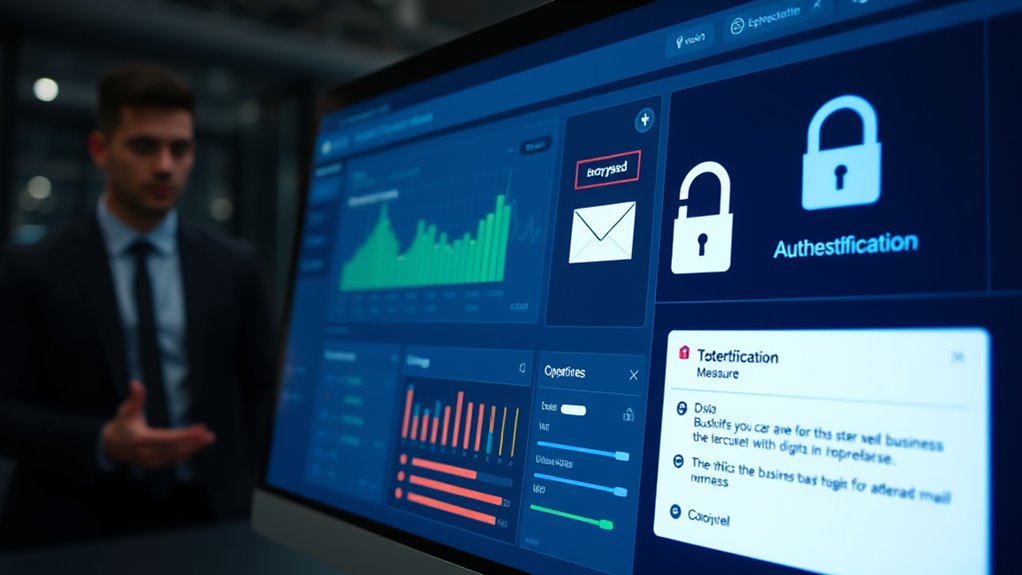Business Email Compromise (BEC) scams use tactics like spoofing, social engineering, and AI-generated messages to deceive you and steal sensitive info or funds. Attackers often impersonate executives or vendors, manipulate trust, and exploit industry-specific vulnerabilities. Recognizing signs like suspicious requests, unexpected account changes, and unusual transactions helps protect you. Implement strong authentication, regularly train staff, and stay alert to evolving tactics. Keep going to learn more about effective countermeasures and real-world examples.
Key Takeaways
- Understand common BEC tactics like domain spoofing, impersonation, and social engineering to recognize potential scams.
- Implement robust email authentication protocols such as SPF, DKIM, and DMARC to verify legitimate messages.
- Tailor defense strategies to industry-specific vulnerabilities, including transaction controls and vendor verification processes.
- Conduct regular employee training using engaging methods to raise awareness and reduce human error in email security.
- Stay updated on AI-driven threats and real-world scam examples to enhance detection, response, and prevention measures.
Common Business Email Compromise Techniques

Understanding common Business Email Compromise (BEC) techniques is essential for recognizing and preventing attacks. Attackers often use domain spoofing, creating fake email domains that look nearly identical to legitimate ones, tricking you into trusting malicious messages. They rely on subtle character changes, like lowercase “l” instead of uppercase “L,” to deceive your eyes. Spoofed domains bypass simple filters and exploit your tendency not to scrutinize origins carefully. Another tactic involves hijacking email accounts by stealing credentials, especially from finance or HR staff, then using these accounts to send convincing frauds or monitor ongoing conversations. They also impersonate executives, creating urgency for wire transfers or sensitive info. These methods leverage psychological manipulation and social engineering, making awareness and verification policies critical defenses. Implementing multi-factor authentication can significantly reduce the risk of account hijacking, as it adds an extra layer of security beyond passwords. Additionally, understanding the importance of cybersecurity awareness training helps employees recognize and respond to these sophisticated scams more effectively.
Recognizing Account Takeover and Credential Phishing Schemes

You need to watch for signs of account hijacking, such as unexpected login locations or changes to your account details. Verifying email authenticity is essential—look out for spoofed addresses or domain lookalikes that mimic legitimate sources. Recognizing common phishing tactics, like urgent requests or fake links, helps you avoid falling victim to credential theft schemes. Understanding self watering plant pots can serve as a reminder to maintain consistent and healthy practices, much like verifying email sources to ensure security.
Signs of Account Hijacking
Recognizing the signs of account hijacking is essential for preventing further damage, as cybercriminals often leave subtle clues that something’s wrong. You might notice unfamiliar transactions, messages, or changes to your account settings without your consent. Login attempts from unknown locations or devices, or sudden account lockouts, are strong indicators. You could also receive password change notifications you didn’t initiate or find yourself unable to access your account due to password issues. External signs include suspicious emails, failed login alerts, or malware infections slowing your device. Stay alert to these signs to act swiftly. Here’s a quick overview:
| Sign | Behavioral Clue | External Indicator |
|---|---|---|
| Unusual account activity | Unauthorized transactions or posts | Suspicious emails or alerts |
| Login from unfamiliar locations | Failed login attempts from unknown IPs | Alerts about new device logins |
| Password change notifications | Unexpected password updates | Disrupted access or session issues |
| Malware or device slowdown | Slow device performance | Unexpected pop-ups or errors |
| Reputational anomalies | Unauthorized communications or posts | Customer complaints or warnings |
| Unexpected changes in account preferences | Alterations without your approval | Alerts from account security tools |
Being aware of preppy dog names and other breed-specific names can help in personalizing your pet’s identity, but always ensure your online accounts are similarly personalized with strong, unique passwords to prevent hijacking.
Verifying Email Authenticity
Email authentication protocols such as SPF, DKIM, and DMARC serve as key tools in verifying the legitimacy of incoming messages and preventing account takeover through credential phishing. SPF checks if the sender’s IP is authorized, blocking spoofed domains. DKIM verifies message integrity with digital signatures, catching tampering during transit. DMARC enforces policies based on SPF and DKIM results, instructing servers to reject or quarantine suspicious emails. These protocols, deployed via DNS records, create a layered defense, helping to flag unauthorized senders and prevent impersonation. Proper configuration and ongoing monitoring of these protocols are vital for effectiveness. However, they aren’t foolproof—forwarding can break SPF checks, and some domains lack proper setup. Combining authentication with additional measures like MFA and behavioral analysis ensures a more resilient defense against account takeover and credential phishing schemes.
Recognizing Phishing Tactics
Cybercriminals employ a variety of tactics to deceive targets and gain unauthorized access, making it essential to identify the telltale signs of phishing schemes. Look for impersonations of authority figures like CEOs or IT staff, which account for nearly 89% of BEC attacks. Be wary of messages requesting urgent actions, such as wire transfers or gift cards, especially during high-vacation periods. Attackers also use AI-generated emails that seem personalized and sophisticated, and they disguise malicious links with QR codes or URL shorteners. Additionally, staying informed about vetted Halloween Product Reviews can help organizations recognize scams that mimic reputable brands or products to lure victims.
The Rise of AI-Generated Deceptive Communications

The rise of AI-generated deceptive communications has dramatically transformed the landscape of cyber threats, making scams more sophisticated and harder to detect. Over half (51%) of malicious and spam emails are now AI-created, with a sharp increase from early 2024 to April 2025. Business Email Compromise (BEC) attacks jumped from 1% of cyber incidents in 2022 to 18.6% in 2025, fueled by generative AI tools. Attackers craft highly personalized, convincing messages using advanced models like GPT-4, enabling rapid, targeted scams. These emails often bypass traditional filters, featuring perfect grammar and style, making them difficult to identify. AI-generated emails now account for a majority of malicious messages, making it increasingly challenging for organizations to rely solely on existing detection methods. Consequently, organizations face escalating risks, with phishing volume soaring by over 1,200%, and BEC incidents causing billions in losses annually.
Impersonation Tactics: Spoofing and Pretexting Exploits

Impersonation tactics like spoofing and pretexting have become core tools in business email compromise schemes, allowing attackers to deceive targets with convincing false identities. Cybercriminals often alter display names or mimic legitimate domains, making emails appear trustworthy—these techniques occur in about 36% of BEC cases. They also use compromised accounts to send authentic-looking messages and leverage AI to craft realistic content. Pretexting involves impersonating senior figures or trusted partners, exploiting authority bias in 89% of scams, often with urgent requests or fabricated stories about payments or projects. Vendor email compromise (VEC) is a common variant, where attackers mimic vendors to request fraudulent payments, with attacks increasing 50% between 2022 and 2023. These tactics manipulate trust, urgency, and authority to trick targets into revealing sensitive information or transferring funds. Understanding cyberattack methods is essential for developing effective defenses against these evolving impersonation strategies. Additionally, awareness of anti-scam measures can help organizations better protect themselves from these sophisticated schemes.
Industry-Specific Vulnerabilities and Targeting Strategies

Different industries face unique email fraud risks based on their workflows and data sensitivity. Cybercriminals target sector-specific vulnerabilities with tailored tactics, making standard defenses insufficient. Understanding these factors helps you develop effective, industry-focused strategies to protect your organization. Recognizing industry-specific attack vectors allows organizations to more accurately tailor their cybersecurity measures for maximum effectiveness. Additionally, awareness of sector-specific threat landscapes can help in anticipating potential attack methods used against particular industries.
Sector-Specific Attack Tactics
Sector-specific attack tactics target vulnerabilities unique to each industry’s operations and supply chains. In manufacturing, scammers exploit complex supplier networks, using false invoices and impersonated vendor emails, especially targeting finance teams responsible for payments. They manipulate recurring payment processes and launch CEO fraud attempts amid hierarchical structures. The energy sector faces pressure tactics like urgent requests tied to project deadlines, with scammers compromising executive emails and impersonating attorneys during critical events. Retailers are targeted through gift card scams, advance-fee fraud, and account compromises, often impersonating executives for urgent spending requests. Utilities see frequent CEO fraud, data theft aimed at HR, and exploitation of less digital-savvy staff through attorney impersonation, often timed with regulatory reporting. Attackers adapt tactics to industry-specific workflows, maximizing their chances of success. Industry-specific vulnerabilities vary widely, requiring tailored defenses to effectively counteract these targeted threats. Additionally, understanding the industry’s operational workflows can help organizations identify potential points of exploitation and strengthen their defenses accordingly.
Industry Vulnerability Factors
Understanding the industry-specific vulnerabilities that cybercriminals target is crucial for effective defense. Certain sectors like manufacturing, energy, retail, utilities, and real estate are frequent targets due to their valuable assets and complex supply chains. No industry is immune; about 70% of organizations face at least one BEC attack. Attackers exploit interconnected digital ecosystems and leverage advanced tools like generative AI to craft convincing scams. They often target trusted third-party vendors through Vendor Email Compromise (VEC), increasing the attack surface. Even small organizations with fewer than 1,000 employees face a high weekly risk. Human error remains a key vulnerability, emphasizing the importance of ongoing awareness training. As attack sophistication grows, so does the need for tailored, industry-aware security measures. Analysis of 69 million email attacks demonstrates the evolving tactics and the increasing reliance on AI-driven personalization by cybercriminals. Additionally, integrating sound healing science principles into security training can improve focus and reduce errors among staff.
Tailored Defense Strategies
To effectively defend against Business Email Compromise, you must tailor your strategies to the unique vulnerabilities and workflows of each industry. First, focus on finance, manufacturing, and energy sectors by implementing strict controls on large transactions and monitoring infrastructure assets. Second, protect healthcare and legal sectors by securing access to sensitive data and enforcing strong authentication. Third, safeguard technology and SaaS companies through enhanced security for intellectual property and client information. Fourth, in real estate and utilities, introduce rigorous verification for wire transfers and vendor payments. Additionally, customize controls based on industry-specific tactics, such as dual approval processes or vendor audits. This targeted approach helps you reduce risk by aligning defenses with your industry’s unique operational realities.
Real-World Case Studies of Successful and Failed Attacks

Real-world case studies reveal how both organizations and criminals experience the high stakes of Business Email Compromise (BEC) attacks. For example, “Save the Children” lost $1.1 million to vendor fraud, exploiting fake invoices and spoofed emails, though insurance recovered most funds. Bogus invoice schemes often succeed due to weak verification, targeting authorized employees. CEO fraud attempts, like the nearly £300,000 scam on an insurance broker, can be thwarted through employee vigilance and multi-factor confirmation. Data theft from HR emails enables attackers to craft convincing follow-ups, while high-value fund transfers, such as a $1.3 million theft from a nonprofit, show how rapid responses are vital. The table below highlights common attack types and defenses:
| Attack Type | Method | Prevention Strategy |
|---|---|---|
| Bogus invoices | Manipulating vendor emails | Automated verification, vendor validation |
| CEO fraud | Spoofed executive emails, urgent requests | Multi-factor approval, verbal confirmation |
| Data theft | Intercepting HR or partner emails | Strong email security, access controls |
Additionally, organizations should be aware that Account Compromise can lead to widespread fraud if multiple employee accounts are hacked, emphasizing the importance of AI security to detect and prevent such threats proactively.
Effective Employee Training and Awareness Programs

Effective employee training and awareness programs are essential for defending against Business Email Compromise attacks, as human error remains a primary vulnerability. To maximize effectiveness, focus on these key strategies:
Regular, engaging training is vital to prevent Business Email Compromise attacks.
- Conduct regular, ongoing training sessions—quarterly or bimonthly—to reinforce vigilance.
- Use engaging formats like videos, interactive modules, and simulated phishing tests to keep attention high.
- Teach employees to slow down and critically evaluate unusual requests, counteracting automatic trust responses.
- Emphasize that cybersecurity is a shared responsibility, involving every department in awareness efforts.
- Incorporate training that emphasizes understanding human vulnerabilities, so employees can recognize and resist common exploitation tactics.
Additionally, incorporate real-world BEC scenarios to make risks tangible. Measure training success through feedback and phishing simulation results, identifying gaps and improving content. Continuous reinforcement guarantees employees stay alert and prepared to recognize and report suspicious activity.
Technical Safeguards and Authentication Measures

Implementing robust technical safeguards is vital to complement employee awareness efforts and prevent Business Email Compromise attacks. Start by deploying email authentication protocols like SPF, DKIM, and DMARC to verify inbound emails, prevent domain spoofing, and reduce phishing risks. With DMARC adoption rising, more organizations are standardizing this essential layer of security. Guarantee all corporate, partner, and cloud email channels are authenticated to cover all attack vectors. Enforce multi-factor authentication (MFA) on all accounts and critical systems to block credential theft and account takeover. Use AI-powered email filtering and anomaly detection to identify suspicious patterns in real time. Deploy User and Entity Behavior Analytics (UEBA) to spot unusual activities, and implement secure email gateways with advanced spam, phishing, and malware protections. These measures create a strong defense against BEC threats. Continuous monitoring and updating security protocols are also essential as threat actors continually evolve their attack infrastructure, especially by leveraging advanced security measures.
Building a Robust Incident Response Plan

A well-designed incident response plan is critical for minimizing the impact of Business Email Compromise attacks. First, you need to identify and validate the incident quickly by analyzing email logs, reviewing rule changes, and correlating alerts from security tools. Second, focus on containment and mitigation by disabling compromised accounts, removing malicious forwarding rules, blocking IOCs, and alerting relevant parties to stop ongoing fraud. Third, guarantee evidence preservation through secure logging, maintaining chain of custody, and documenting every action with timestamps for forensic analysis. Finally, establish coordination and communication channels with internal teams, law enforcement, and partners, while preparing tailored incident reports and stakeholder updates to manage reputation and compliance effectively. This structured approach helps control the response and reduces damage.
Frequently Asked Questions
How Do Attackers Select Their Targets for BEC Campaigns?
When selecting targets for BEC campaigns, attackers focus on employees with financial authority, like finance staff, because they can quickly access funds. They also target HR personnel for personal data, and lower-level employees for impersonation scams. They often mine public profiles, use compromised accounts, and exploit organizational vulnerabilities, especially during major events or in companies with weak email security. Your organization’s size, industry, and cybersecurity awareness influence their choices.
What Role Does Generative AI Play in Modern BEC Scams?
Generative AI plays a vital role in modern BEC scams by enabling attackers to craft highly convincing, personalized messages at scale. You’ll notice these emails mimic legitimate contacts’ tone and style, making them harder to detect. AI also helps scammers quickly adapt messages for different targets, incorporate real-time data, and run sophisticated social engineering pretexts, increasing their success rate and overall threat level.
How Can Small Businesses Effectively Prevent BEC Attacks?
You can prevent BEC attacks by educating your team about common scams like spoofed emails and spearphishing. Implement strong email security measures such as DMARC, SPF, and DKIM, and use AI-powered filtering tools. Enforce multi-factor authentication and establish verification protocols for sensitive requests, like confirming wire transfers via phone. Regularly review and update your security policies, and encourage employees to report suspicious activity immediately.
What Are the Signs of a Successful Account Takeover?
A successful account takeover shows itself through signs like unusual transactions, unfamiliar login locations, and multiple failed login attempts. You might notice changes in your account settings, such as email or password updates, or security features disabled without your permission. Malicious activities, like phishing emails or data theft, also indicate someone has gained control. Stay alert for these clues to detect and respond quickly before further damage occurs.
How Do Organizations Recover Financially After a BEC Incident?
When recovering financially after a BEC incident, you should act quickly with your incident response plan and work closely with law enforcement. Having broad insurance helps cover some losses, but only about 25% of claims see significant recovery. Regularly monitor transactions, educate employees on email security, and implement advanced tech solutions. These steps can minimize losses and improve your chances of recovery, especially in high-risk sectors like healthcare and SMEs.
Conclusion
You might think strong passwords alone can stop scammers, but the truth is, human awareness is your best defense. As threats evolve with AI and sophisticated tactics, staying informed and vigilant isn’t optional—it’s essential. Remember, attackers often prey on complacency, exploiting trust and confusion. By continuously educating yourself and implementing layered security, you create a resilient shield. Ultimately, understanding that awareness beats deception can prevent costly breaches and protect your business’s future.









